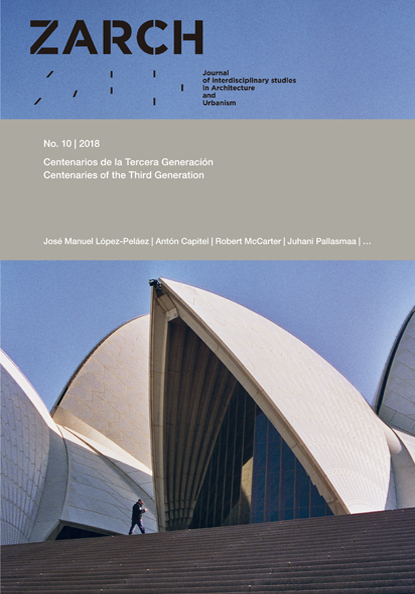A new imaginary: contributions of women in America
DOI:
https://doi.org/10.26754/ojs_zarch/zarch.2018102944Keywords:
Black Mountain College, women, nothing, laboratories, idea, hiddenAbstract
The arrival to Berlin of Nazis SS troopes in 1933 caused the exodus of European artists and architects. They flight together with their wifes escaping from an imminent war. Many of them found the promise of a new opportunity in North Carolina: the Black Mountain College. An experimental school opened its doors in the middle of an economic recession, with the goal of teaching to think. Prominent European figures arrived to North Carolina with the hope of continuing their projects. Their wifes and female colleagues turned the nothing which they find to a big opportunity. With them other women joined Black Mountain College experience and created a new generation hidden for the men’s practice. Women, used to work with practically nothing, found there the framework for the beginning of a new way of thinking. The classrooms were opened to new fields like mathematics or geometry turning the European ateliers into experimental laboratories. Anni Albers showed these women how to weave the nothing as a new matter. With her, Ruth Asawa, Dorotea Rokburne and Anne Tyng built a new way of thinking detached, as they, of any material. This hidden generation didn´t provide built samples, but a new imaginary for another architecture.
Downloads
References
Albers, Anni. 1938. Material as a metaphor. Black Mountain College Bulletin 5.
Albers, Anni. 1938. Work with Material. Carolina del Norte: Black Mountain College Bulletin 5.
Albers, Anni. 1951. On Designing, New Heaven: Pellango Press.
Albers, Anni. 1965. On weaving. Middletown Conn: Wesleyan University Press.
Blume, Eugen. 2015. Science and its double. En Black Mountain, an interdisciplinary experiment 1933-1957. Leipzig: Spector Books.
Boostic, Conie. 2002. Dorothea Rockburne Interview. Black Mountain College Journal. http://www.blackmountainstudiesjournal.org/volume-11-spring-2011/1-1-dorothea-rockburne-interview/ (consultado el 16 de julio de 2017).
Buckminster Fuller, Richard. 1962. Education Automation. Carbondale, Illinois: Southern Illinois University Press.
Dreier, Theodore. 1933. Carta enviada a Josef Albers.
Duberman, Martin. 1972. Black Mountain College: An Exploration in Community. New York: Dutton.
Harris, Mary Emma. 1987. The arts at Black Mountin Collage. Cambridge, MA: MIT Press.
Harris, M. E.; Benfey, C.; Díaz. E.; de Waal E.; Perl J. 2005. Starting at Zero: Black Mountain College 1933-1957. Bristol: Arnolfini.
Juárez Chicote, Antonio. 2006. El universo imaginario en Louis I. Kahn. Barcelona: Fundación Caja de Arquitectos. Arquia tesis/20.
Moleswort, Helen. 2015. Leap before you look: Black Mountain College 1933-1957. Boston: Institute of Contemporary Art, Boston/Yale University Press.
Olson, Charles. 1974. Olson: the journal of the Charles Olson Archives n. 10. Connecticut: University of Connecticut Library Storrs.
Rosenburg, Karen. 2013. Mathematical Ratios, Papered, Folded and Cut Dorothea Rockburne’s Drawings at the Museum of Modern Art. The New York Times. Nueva York, 12 de diciembre.
Solomon May, Deborah. 2017. For Robert Rauschenberg, No Artist Is an Island. The New York Times. https://www.nytimes.com/2017/05/11/arts/design/for-robert-rauschenberg-no-artist-is-an-island.html (consultado el 9 de enero de 2018).
Tyng, Anne. 1986. Interview by Alessandra Latour. En Louis I. Kahn, l`uomo, il maestro. Roma: Edizioni Kappa.


